Abstract
OBJECTIVES: Irregular working hours severely disturb sleep and wakefulness. This paper presents a modification of the quantitative (computerised) three process model of regulation of alertness to predict duration of sleep in connection with irregular sleep patterns. METHODS: The model uses a circadian "C" (sinusoidal) and homeostatic "S" (exponential) component (the duration of previous periods awake and asleep), which are summed to yield predicted alertness (on a scale of 1-16). It assumes that waking from sleep will occur at a given alertness level (S' + C') when recuperation is complete. Variables of electroencephalographic duration of sleep from two studies of irregular sleep were used to model the S and C variables in a regression approach to maximise prediction. The model performance was cross validated against published field and laboratory data. RESULTS: The model parameters were defined with a high degree of precision R2 = 0.99 and the validation yielded similar values R2 = 0.98-0.95, depending on the acrophase. The paper also describes a simplified graphical version of the computation model seen as a two dimensional duration of sleep nomogram. CONCLUSION: The model seems to predict group means for duration of sleep with high precision and may serve as a tool for evaluating work and rest schedules to reduce risks of sleep disturbances.
Full text
PDF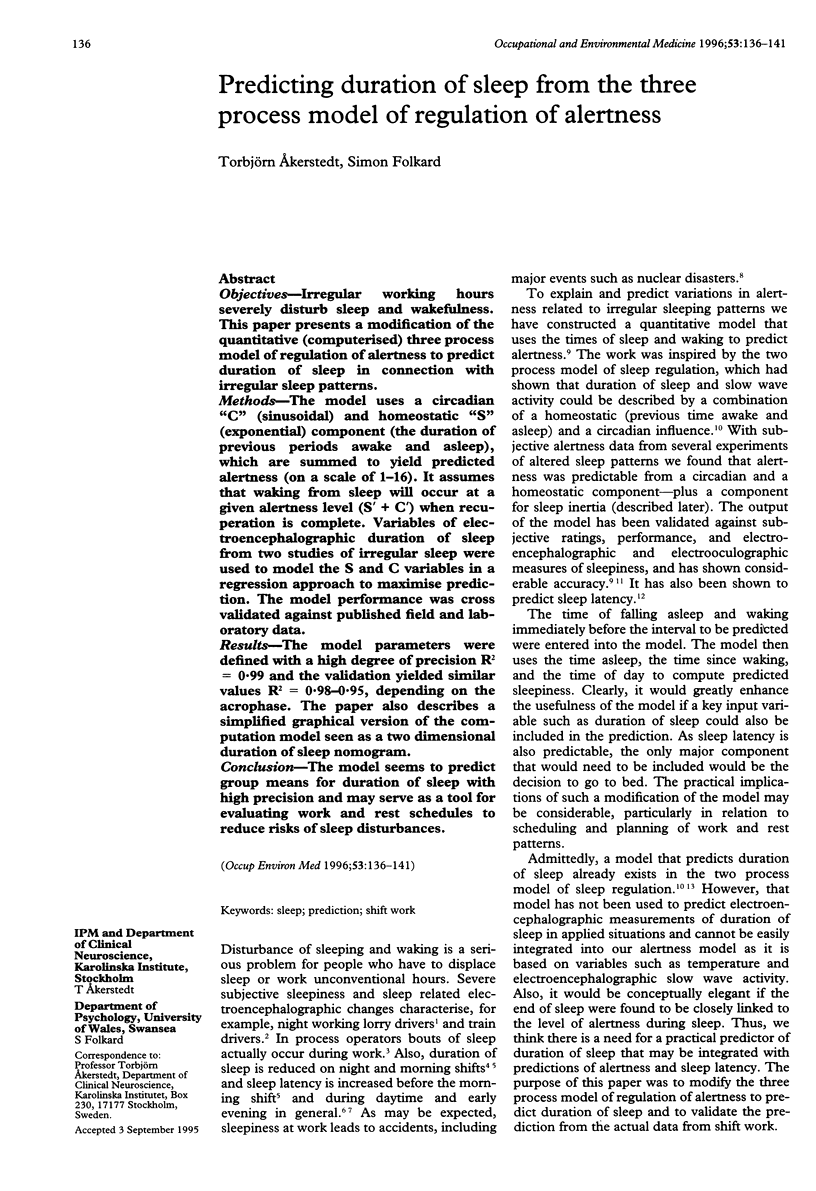

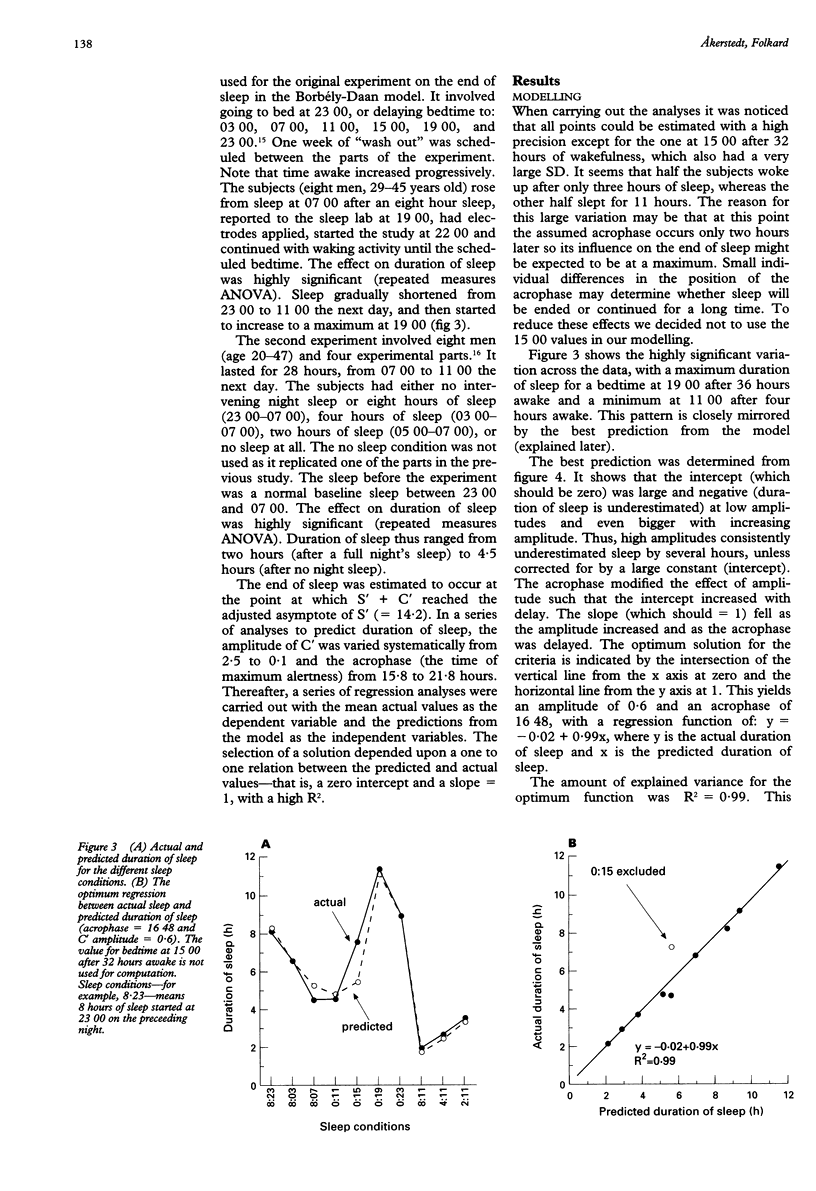
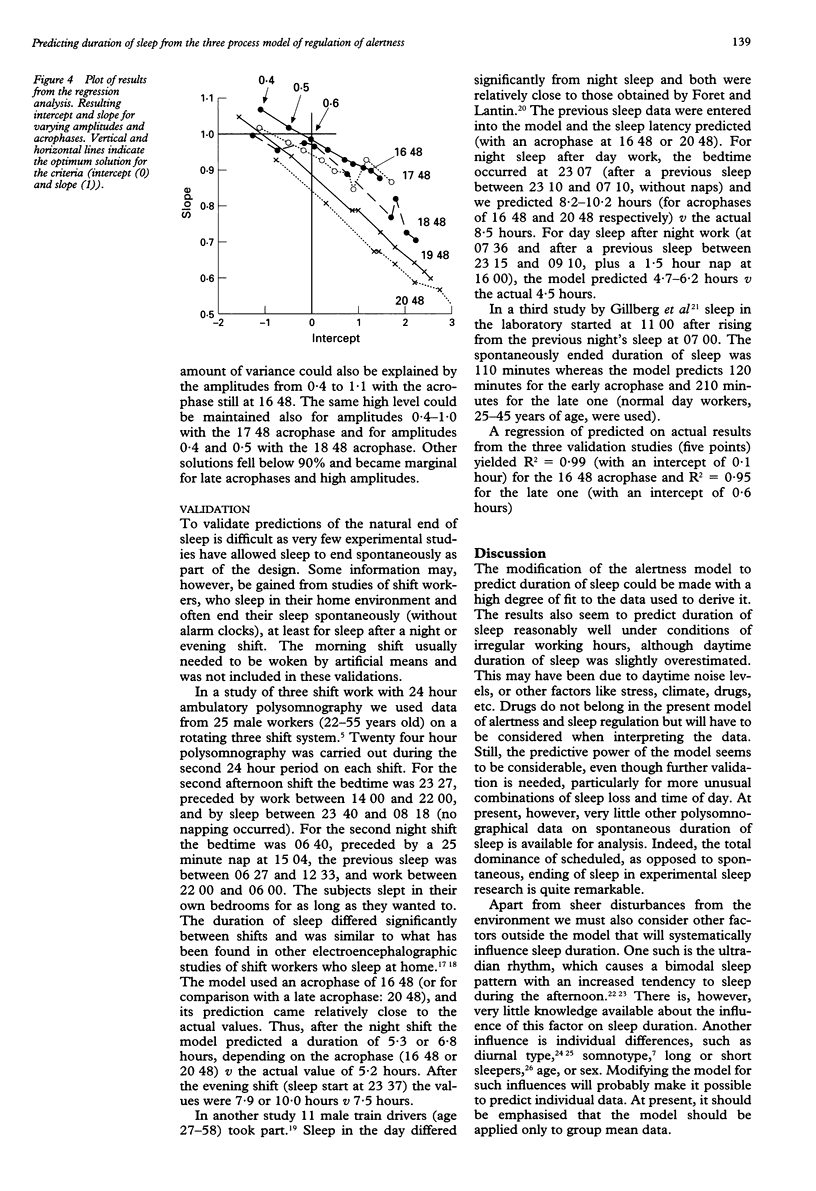
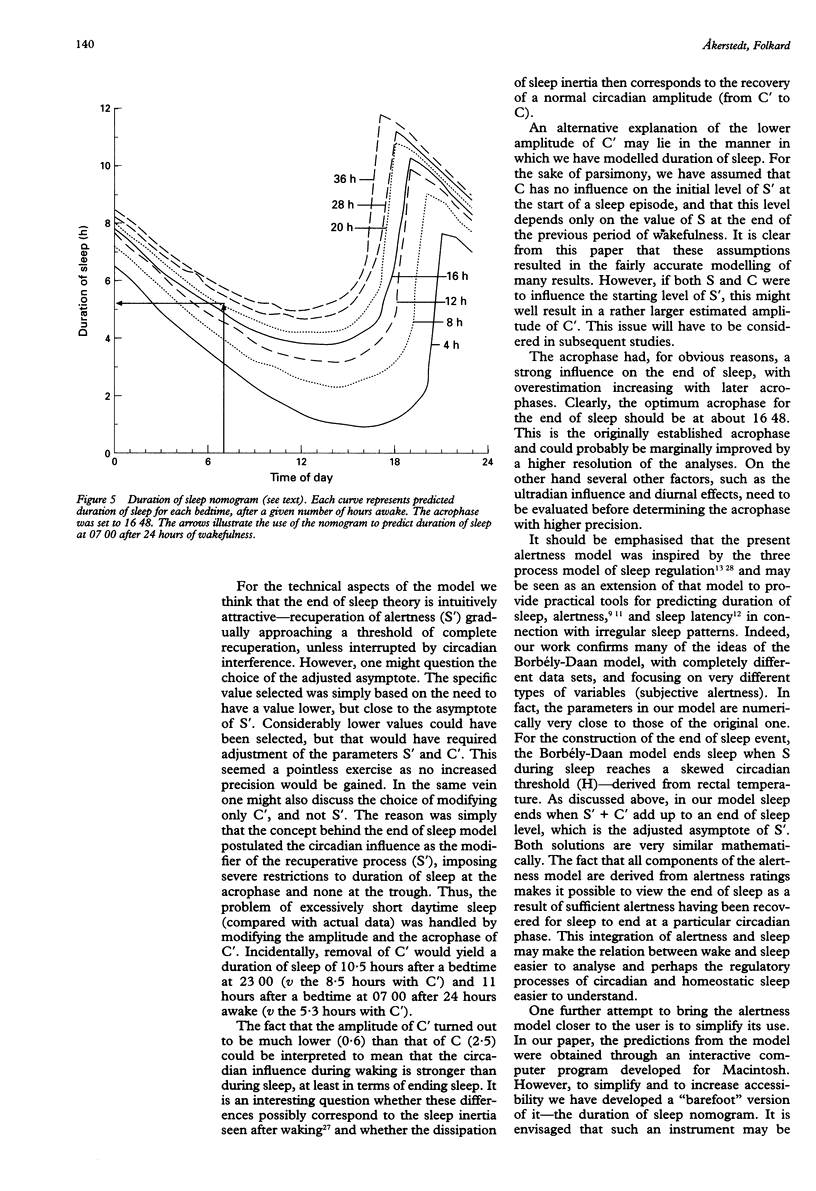
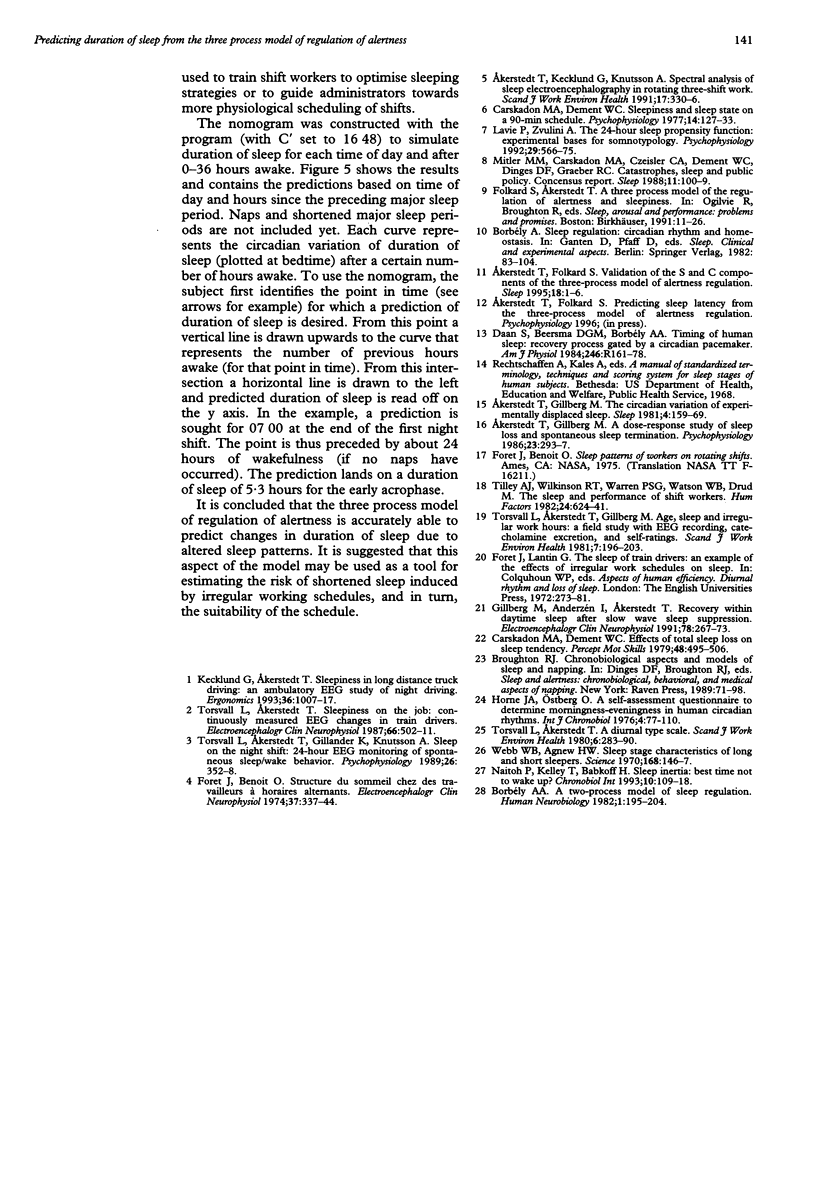
Selected References
These references are in PubMed. This may not be the complete list of references from this article.
- Akerstedt T., Folkard S. Validation of the S and C components of the three-process model of alertness regulation. Sleep. 1995 Jan;18(1):1–6. doi: 10.1093/sleep/18.1.1. [DOI] [PubMed] [Google Scholar]
- Akerstedt T., Gillberg M. A dose-response study of sleep loss and spontaneous sleep termination. Psychophysiology. 1986 May;23(3):293–297. doi: 10.1111/j.1469-8986.1986.tb00635.x. [DOI] [PubMed] [Google Scholar]
- Akerstedt T., Gillberg M. The circadian variation of experimentally displaced sleep. Sleep. 1981;4(2):159–169. doi: 10.1093/sleep/4.2.159. [DOI] [PubMed] [Google Scholar]
- Akerstedt T., Kecklund G., Knutsson A. Spectral analysis of sleep electroencephalography in rotating three-shift work. Scand J Work Environ Health. 1991 Oct;17(5):330–336. doi: 10.5271/sjweh.1694. [DOI] [PubMed] [Google Scholar]
- Borbély A. A. A two process model of sleep regulation. Hum Neurobiol. 1982;1(3):195–204. [PubMed] [Google Scholar]
- Carskadon M. A., Dement W. C. Effects of total sleep loss on sleep tendency. Percept Mot Skills. 1979 Apr;48(2):495–506. doi: 10.2466/pms.1979.48.2.495. [DOI] [PubMed] [Google Scholar]
- Carskadon M. A., Dement W. C. Sleepiness and sleep state on a 90-min schedule. Psychophysiology. 1977 Mar;14(2):127–133. doi: 10.1111/j.1469-8986.1977.tb03362.x. [DOI] [PubMed] [Google Scholar]
- Daan S., Beersma D. G., Borbély A. A. Timing of human sleep: recovery process gated by a circadian pacemaker. Am J Physiol. 1984 Feb;246(2 Pt 2):R161–R183. doi: 10.1152/ajpregu.1984.246.2.R161. [DOI] [PubMed] [Google Scholar]
- Gillberg M., Anderzén I., Akerstedt T. Recovery within day-time sleep after slow wave sleep suppression. Electroencephalogr Clin Neurophysiol. 1991 Apr;78(4):267–273. doi: 10.1016/0013-4694(91)90180-c. [DOI] [PubMed] [Google Scholar]
- Kecklund G., Akerstedt T. Sleepiness in long distance truck driving: an ambulatory EEG study of night driving. Ergonomics. 1993 Sep;36(9):1007–1017. doi: 10.1080/00140139308967973. [DOI] [PubMed] [Google Scholar]
- Lavie P., Zvuluni A. The 24-hour sleep propensity function: experimental bases for somnotypology. Psychophysiology. 1992 Sep;29(5):566–575. doi: 10.1111/j.1469-8986.1992.tb02032.x. [DOI] [PubMed] [Google Scholar]
- Mitler M. M., Carskadon M. A., Czeisler C. A., Dement W. C., Dinges D. F., Graeber R. C. Catastrophes, sleep, and public policy: consensus report. Sleep. 1988 Feb;11(1):100–109. doi: 10.1093/sleep/11.1.100. [DOI] [PMC free article] [PubMed] [Google Scholar]
- Naitoh P., Kelly T., Babkoff H. Sleep inertia: best time not to wake up? Chronobiol Int. 1993 Apr;10(2):109–118. doi: 10.1080/07420529309059699. [DOI] [PubMed] [Google Scholar]
- Torsvall L., Akerstedt T. A diurnal type scale. Construction, consistency and validation in shift work. Scand J Work Environ Health. 1980 Dec;6(4):283–290. doi: 10.5271/sjweh.2608. [DOI] [PubMed] [Google Scholar]
- Torsvall L., Akerstedt T., Gillander K., Knutsson A. Sleep on the night shift: 24-hour EEG monitoring of spontaneous sleep/wake behavior. Psychophysiology. 1989 May;26(3):352–358. doi: 10.1111/j.1469-8986.1989.tb01934.x. [DOI] [PubMed] [Google Scholar]
- Torsvall L., Akerstedt T. Sleepiness on the job: continuously measured EEG changes in train drivers. Electroencephalogr Clin Neurophysiol. 1987 Jun;66(6):502–511. doi: 10.1016/0013-4694(87)90096-4. [DOI] [PubMed] [Google Scholar]
- Webb W. B., Agnew H. W., Jr Sleep stage characteristics of long and short sleepers. Science. 1970 Apr 3;168(3927):146–147. doi: 10.1126/science.168.3927.146. [DOI] [PubMed] [Google Scholar]


